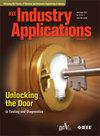Magnetostriction Effect on Vibration and Acoustic Noise in Switched Reluctance Motor
IF 4.2
2区 工程技术
Q2 ENGINEERING, ELECTRICAL & ELECTRONIC
引用次数: 0
Abstract
The contribution of magnetostriction to vibration and acoustic noise in switched reluctance motors is investigated through finite element analysis and experiment on two motors. One motor was constructed using the 6.5% high-silicon steel 10JNEX900 with a low magnetostriction (0.3 ppm at 1 T), whereas the other motor was made of the amorphous iron 2605SA1 with a high magnetostriction (11.0 ppm at 1 T). Finite element analyses were performed on two cases: a static excitation and a typical motor operation. In the case of the static excitation, the magnetostrictive deformation is not only significant but also counteracts the deformation caused by the electromagnetic force, reducing the total deformation. In the case of the typical motor operation, a similar counteraction effect due to magnetostriction was confirmed in mode-0 (breathing mode) vibrations in the amorphous iron motor. This counteraction effect in both mode-0 vibration and acoustic noise was also verified in the experiment. Such experimental results, which highlight the significance of magnetostriction for motor vibration and acoustic noise, have not been reported in the existing literature. The analytical and experimental findings of this study suggest that magnetostriction should be considered when assessing the vibration and acoustic noise of motors made of high-magnetostriction core materials.磁致伸缩对开关磁阻电机振动和噪声的影响
通过对两台开关磁阻电机的有限元分析和实验,研究了磁致伸缩对开关磁阻电机振动和噪声的贡献。其中一个电机采用低磁致伸缩(1 T时为0.3 ppm)的6.5%高硅钢10JNEX900制造,而另一个电机采用高磁致伸缩(1 T时为11.0 ppm)的非晶铁2605SA1制造。对静态激励和典型电机运行两种情况进行了有限元分析。在静态激励的情况下,磁致伸缩变形不仅显著,而且抵消了电磁力引起的变形,减小了总变形。在典型电机运行的情况下,在非晶铁电机的模式0(呼吸模式)振动中证实了由磁致伸缩引起的类似反作用力。实验也验证了这种零模态振动和噪声的抵消效应。这一实验结果突出了磁致伸缩对电机振动和噪声的重要性,但在现有文献中尚未见报道。本研究的分析和实验结果表明,在评估高磁致伸缩磁芯材料制成的电机的振动和噪声时,应考虑磁致伸缩。
本文章由计算机程序翻译,如有差异,请以英文原文为准。
求助全文
约1分钟内获得全文
求助全文
来源期刊

IEEE Transactions on Industry Applications
工程技术-工程:电子与电气
CiteScore
9.90
自引率
9.10%
发文量
747
审稿时长
3.3 months
期刊介绍:
The scope of the IEEE Transactions on Industry Applications includes all scope items of the IEEE Industry Applications Society, that is, the advancement of the theory and practice of electrical and electronic engineering in the development, design, manufacture, and application of electrical systems, apparatus, devices, and controls to the processes and equipment of industry and commerce; the promotion of safe, reliable, and economic installations; industry leadership in energy conservation and environmental, health, and safety issues; the creation of voluntary engineering standards and recommended practices; and the professional development of its membership.
 求助内容:
求助内容: 应助结果提醒方式:
应助结果提醒方式:


